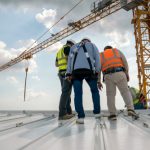What do Steel Structure Inspections Entail?
September 29, 2023 4:02 pm Leave your thoughts
1. Visual Inspection
A visual inspection is the initial step in assessing the condition of a steel structure. It involves a thorough examination of the structure’s components, including beams, columns, joints, and connections. The inspector looks for signs of corrosion, deformation, cracks, and other visible damages. They also check for proper alignment and ensure that all fasteners are securely in place. This inspection helps identify any visible defects that may compromise the structural integrity of the steel components.
2. Non-Destructive Testing (NDT)
Non-destructive testing is a crucial part of steel structure inspections. It involves using various techniques to evaluate the properties and characteristics of the steel without causing damage. Common NDT methods used in steel structure inspections include ultrasonic testing, magnetic particle testing, liquid penetrant testing, and radiographic testing. These tests help detect hidden defects such as cracks, internal corrosion, or inadequate welds. NDT provides valuable information about the condition of the steel, helping inspectors identify potential issues before they lead to structural failure.
3. Load Testing
Load testing is performed to assess the structural capacity and stability of a steel structure. It involves applying simulated or actual loads to determine how the structure responds. Load testing helps validate the design assumptions and assesses the structure’s ability to withstand anticipated loads and stress conditions. This testing can involve static or dynamic loads and is carried out according to specific industry standards and regulations.
4. Corrosion Assessment
Corrosion is a common concern for steel structures, as it can weaken the material and compromise its structural integrity. During a steel structure inspection, inspectors assess the extent of corrosion on the steel components. They look for signs of rust, pitting, and surface deterioration. Various techniques, such as visual examination, ultrasonic thickness measurement, and corrosion mapping, may be used to evaluate the level of corrosion and its impact on the structure. This assessment helps determine the appropriate corrosion protection measures and maintenance strategies.
5. Weld Inspection
Welded connections play a crucial role in steel structures, providing strength and stability. During a steel structure inspection, inspectors carefully examine the welded joints to ensure they meet the required standards. They check for proper weld penetration, fusion, and the absence of cracks or defects. Inspectors may use visual inspection, radiographic testing, or ultrasonic testing to assess the quality of welds. A comprehensive weld inspection is essential to ensure the integrity of the steel structure and prevent potential failures due to welding defects.
6. Environmental Assessment
Environmental factors can significantly impact the condition of steel structures. Inspectors assess the environmental conditions surrounding the structure, such as exposure to humidity, moisture, temperature variations, and corrosive substances. They also evaluate the effectiveness of protective coatings, such as paint or galvanization. This assessment helps identify potential sources of corrosion, deterioration, or other damages caused by the environment. Inspectors may recommend protective measures or maintenance practices to mitigate these effects.
7. Documentation and Reporting
After completing the steel structure inspection, inspectors compile a detailed report documenting their findings. The report includes a summary of the inspection process, observations, identified defects or issues, and recommendations for repairs or maintenance. This documentation serves as a valuable reference for property owners, engineers, and other stakeholders. It helps guide decision-making regarding necessary repairs, upgrades, or modifications to ensure the safety and longevity of the steel structure.
Conclusion
Steel structure inspections are comprehensive processes that evaluate the condition and integrity of steel components. Through visual inspections, non-destructive testing, load testing, corrosion assessments, weld inspections, environmental assessments, and detailed documentation, inspectors provide crucial insights into the safety and functionality of steel structures. Regular inspections ensure that any defects or damages are identified and addressed promptly, reducing the risk of structural failure and prolonging the lifespan of the steel structure.
Got Questions? Let Us Help!
Benchmark Fabricated Steel is a premium service provider for all your metal and steel needs since 1971. We offer an array of services and products for commercial, business, and corporation work. Our fully trained team is available for project design, erect drawings, site construction, product procurement and delivery, engineering and consulting, and much more. Benchmark Fabricated Steel is fully accredited by the AISC and the Canadian welding association allowing for the highest quality product to be produced. Our business is also recognized by the Chamber of Commerce and is a fully certified fabricator. All of our products are manufactured by the highest quality of equipment, with an expert and knowledgeable staff. Contact us today to learn more about what we can do for you!
Categorised in: Structural Steel
This post was written by admin
